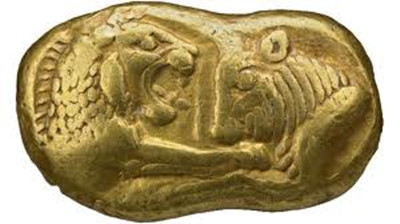Croesus was a king in what's now western Turkey.
克罗伊斯曾经是今土耳其西部地区的王。
His kingdom, Lydia, was among the new powers that emerged across the Middle East about three thousand years ago, so it was part of that wider political upheaval that I've been exploring this week.
他的王国吕底亚是三千年前中东地区涌现的新势力之一。因此这是我本周一直在探索更广泛的政治动荡的其中之一。
But in this programme, I want to look at a different kind of new power -or more precisely, I want to look at the creation of a new type of object that would ultimately become a power in its own right: coinage.
正是这些金币让吕底亚和克罗伊斯王富甲一方。它是一种新形式的物品,靠自身的价值获得力量。
We've all grown so accustomed to using little round pieces of metal to buy things, that it's easy to forget that coins arrived quite late in the history of the world.
我们现在都很习惯用小而圆的金属块购买物品,但很少有人知道,货币在世界舞台上出现的时间并不太长。
For over two thousand years, states ran complex economies and international trading networks without a coin to hand.
在超过两千年的时间里,世界各国拥有复杂的经济制度和国际贸易网络,却并没有货币。
The Egyptians, for example, used a sophisticated system that measured value against standard weights of copper and gold, but as new states and new ways of organising trade emerged, coinage began to make an appearance, and fascinatingly, it happened independently in two different parts of the world at almost the same time.
比如埃及,就曾使用一套以铜和金的标准重量为基准的复杂体系来衡量价值。但随着新的国家与新的贸易线路不断产生,对货币的需求产生了。奇妙的是,货币几乎是同时在两个相隔甚远的地区独立出现的。
In China they began using miniature spades and knives in very much the same way that we would now use coins, and virtually simultaneously in the Mediterranean world, the Lydians started making actual coins as we would recognise them today-round shapes in precious metals.
中国人发明的通货外形像小型的矛和刀,但用途与今天的货币别无二致。而在中东地区,吕底亚制造的货币我们今天仍能一眼认出—他们釆用了与如今货币相 同的圆形贵金属片。













